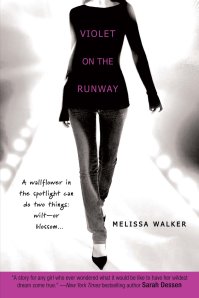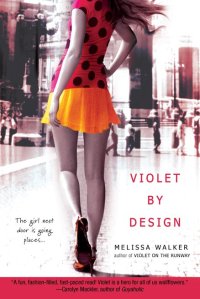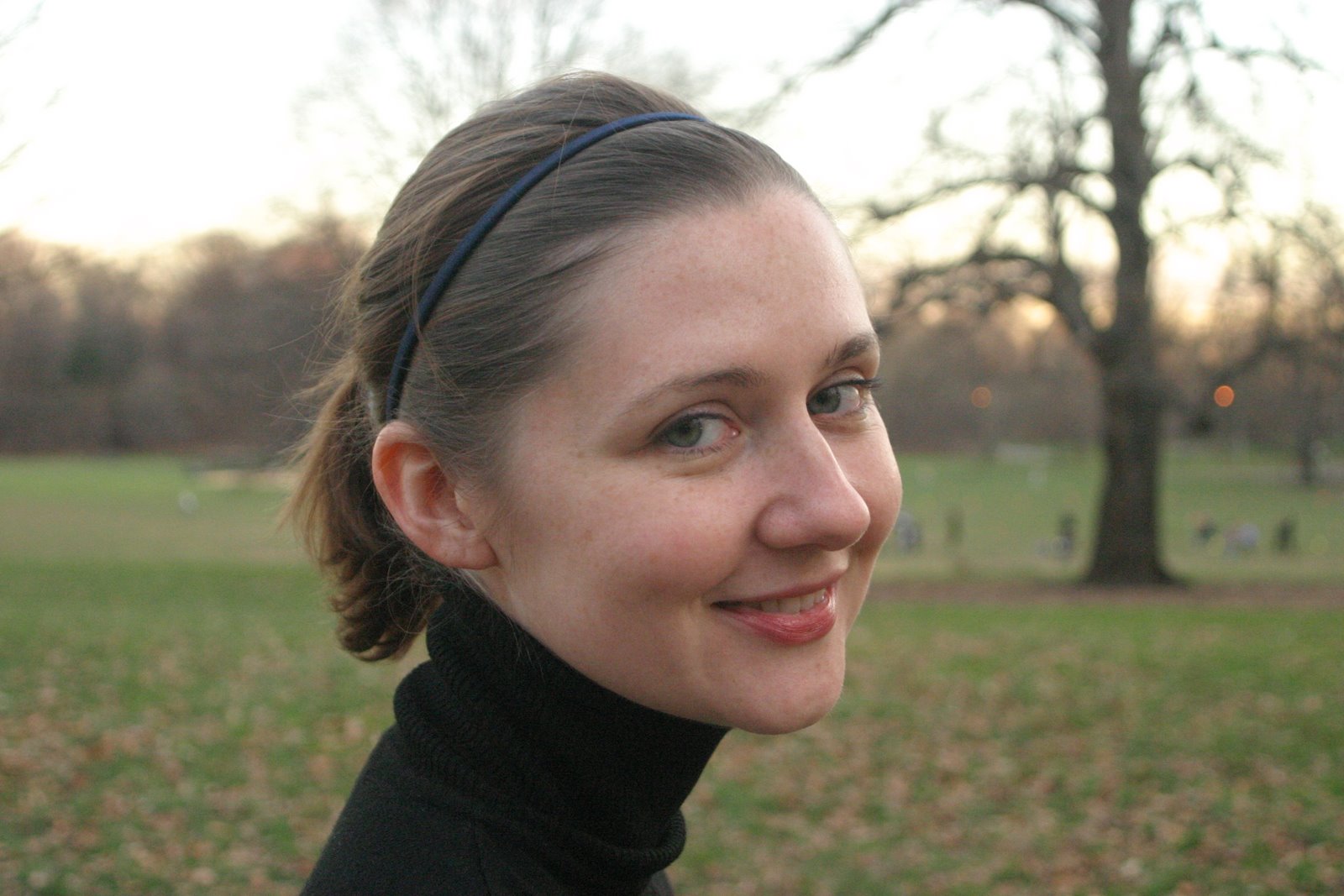 Come on. Admit it. Have you ever dreamed of being discovered? Or wondered what it would be like to be dressed in sumptuous designer clothes, strut down a runway and strike a pose? Do you enjoy watching shows like Project Runway or America’s Top Model?
Come on. Admit it. Have you ever dreamed of being discovered? Or wondered what it would be like to be dressed in sumptuous designer clothes, strut down a runway and strike a pose? Do you enjoy watching shows like Project Runway or America’s Top Model?
“A story for any girl who ever wondered what it would be like to have your wildest dreams come true.”
—New York Times bestselling author Sarah Dessen
“A fun, fashion-filled, fast-paced read!”
—Carolyn Mackler, author of Guyaholic
HWM: You’ve had what some people would consider a “glamorous” career in the magazine industry. What made you want to write books for teens? How did you get your “break” into getting published?
Melissa: I love writing for teenagers because I think they’re such an honest, open audience. They’ll tell you if they love a story and they’ll call you out if something just sucks.
As for getting published book-wise, I did things backwards. First I contacted a fantastic YA writer I know, Carolyn Mackler, to ask her advice on pitching a YA novel. She directed me to an editor at Penguin’s Berkley JAM, who was looking for new writers. That editor took a look at my magazine clips, and I sent her a one-page summary of what I imagined Violet on the Runway would be about. She asked to see the first two chapters, so I sat down to write those and sent them in.
Shockingly, she came back with an offer. I was thrilled, but also scared, so I asked her to give me a week to find an agent. I turned to published friends who gave me lots of solid advice, and eventually I talked to Doug Stewart of Sterling Lord Literistic, whom I had met at a book party five years earlier (my first book party in NYC!). I spoke with a few agents but really felt a connection with Doug. We talked, we signed.
Doug thought that we should shop the summary and chapters around, so we did, and another house also made an offer. Then he asked both Penguin and the other house to have their very best offers in by Monday at noon. (It was a total old west showdown, at least in my mind).
In the end, Berkley JAM was promising to put the book out faster, they wanted three books total, so we went with Penguin.
 HWM: What inspired the Violet series?
HWM: What inspired the Violet series?
Melissa: As soon as I started peeking behind the scenes of modeling and fashion as a magazine editor, I knew that I wanted to put a “real girl” in the middle of this crazy world, a girl who would see it from the outside and be like, “Holy crap!” It’s an insane environment, so there’s lots of fodder for adventure, humor and drama, especially from the point of view of a small town girl who’s not yet jaded.
My time at ElleGirl especially gave me insight into the fashion world and how newer models live in NYC (which can be glamorous, scary, thrilling, and a little dark all at the same time). That knowledge kind of overlapped with my long-time dream of writing a teen novel about a small town girl in the big city (original, right?). The fashion world thing gave it more focus and helped me nail down the plot.
HWM: When you sold the books as a three-book deal, did you know how the series would end? What advice do you have for writers who want to pitch a series?
Melissa: I had no idea! I actually pitched Violet on the Runway as a standalone book, and it was the publisher who suggested a series, so I had to think up a couple more plotlines rather quickly.
HWM: How did you celebrate the release of each of your books?
Melissa: For the first and the third books, mediabistro.com threw book parties, which were very fun! For the second, we partnered with Lancome during February’s Fashion Week and did a party at one of their boutiques—also very fun!
HWM: Fashions change. Did you worry about dating your books by using some names of real designers and models?
Melissa: Nah, the names I dropped are pretty timeless, I think, and if any of them do become dated, I hope readers will just think they are made up!
HWM: What are some of the things you had to do, in the name of research for the Violet books?
Melissa: I didn’t have to do much because my real research—being backstage at fashion shows, learning what went on with models—was already done. I had spent a few years watching and reporting on that world for magazines.
HWM: There are some topics in the Violet series that might make some parents nervous. What message, if any, would you like them to know?
Meliss
a: I wanted to write a realistic portrayal of the modeling world, and that does include drugs and eating disorders. I didn’t want to sugar-coat the business and make it seem like a fantasy, because it’s not. However, rest assured that though Violet struggles with some decisions, she always lands on her feet and stays true to herself, largely due to her fantastic friends from home.
HWM: You were the featured author over at readergirlz in August. There was discussion about body image, pressure, and beauty. What message would you like teens to get from your books?
Melissa: In a book about the fashion world, body image issues are impossible to ignore, so I had to let Violet deal with the issue and figure it out in her own, sometimes flawed, human way. I think the fact that she doesn’t have the issue quite clear in her head makes it less of a moralizing moment and more of a true gray area that girls encounter. I just hope that readers sympathize with Violet and can see their own situations a little more clearly.
HWM: What is your favorite part of being an author of YA books?
Melissa: The reader emails, for sure. I love engaging with people who’ve found something that resonated with them in the books. It’s inspiring!
 HWM: Do you find your magazine background helped you with ideas for marketing your books to teens? Nowadays, authors need to take an active role in marketing. What are some things you’ve done?
HWM: Do you find your magazine background helped you with ideas for marketing your books to teens? Nowadays, authors need to take an active role in marketing. What are some things you’ve done?
Melissa: Yes, definitely. Because I still pitch and write for magazines regularly, I know how to craft a pitch that’s more effective than, “Please cover my book!” which is how most editors are approached by publishers, I’ve found. For example, I pitched a roundup of modeling books to the NY Times and sent them a list of titles, including Violet. They ended up running this story in the STYLE magazine that included Violet on the Runway and Model, by Cheryl Diamond.
I also made my own press kits and sent them to venues I knew my publisher wasn’t in touch with, like NC papers near my hometown (and Violet’s), which led to stories like this and this.
For those, I pitched different ideas and noted talking points that I could speak to in an interview. Those little extra touches help reporters and editors see where you’ll fit into their publications.
HWM: Would you share some tips on how to make a good pitch to a magazine?
Melissa: In terms of pitching, there are three main keys, as I see it:
1. Know the venue (sounds easy, but you’d be surprised at how many people try pitching parenting stories to, say, teen magazines).
2. Know the format of the page you’re pitching. Is it always a book roundup? Then come to them with a few books that fit alongside yours. Do they not to do reviews, but instead publish essays by authors? Then write an essay. It’s your job to fit into what editors need, not the other way around.
3. Be timely. Monthly magazines decide on editorial lineups 4-5 months in advance, and they need advance copies early. A galley just one month out? Send it to weeklies, dailies and blogs!
HWM: What project(s) are you working on now?
Melissa: I just finished a book for HarperTeen called LOVESTRUCK SUMMER, and it will be out in May 2009!
HWM: Congratulations on being the newest readergirlz diva! What do you hope to bring to the table?
Melissa: Thanks! I’m going to be the blogging diva, so mostly I’ll be posting news and interviews and updates and fun things on our new blog: readergirlz.blogspot.com.
HWM: All of the Violet books have been published as original paperbacks rather than hardcover. What is your opinion about this trend?
Melissa: I think teens buy paperbacks, and that’s who I wanted to sell to, so I wasn’t concerned about missing out on hardcover.
HWM: What is your writing process or ritual?
Melissa: When I’m on a deadline for a book, I eat breakfast, then write. I don’t allow myself to have lunch until I have 1,000 words on the page. They don’t have to be good words, but they have to be there. I do that five days a week; afternoons are spent working on magazine stories. At that rate, you can get your 60,000 words in just 12 weeks. Of course, some days I play hooky in Prospect Park, some days I have lunch dates in the city so I just wrote 300 words, etc. I have to let myself enjoy the perks of being freelance sometimes! But in general, I am pretty consistent with the 1,000-word rule.
HWM: What was the best writing advice anyone ever gave you?
Melissa: Read, read, read. You’ll learn a lot that way about pacing, characterization, plot, etc.
HWM: What is your most memorable fan moment?
Melissa: On the day Violet By Design was released, I walked into my local bookstore and saw a girl carrying it around. I screamed and introduced myself, and I manically signed it for her. She later myspace messaged me to say it made
her happy, but I think I scared her at first!
HWM: If you found a way to go back to your teen years as one of your characters, who would it be and why?
Melissa: It would be Violet, because she’s a lot like me in many ways, but she gets to wear amazing clothes!
HWM: What makes you laugh?
Melissa: My friends who’ve known me since I was 13. I never laugh so hard as when I’m with them.
HWM: If you were a superhero, what powers would you want and why?
Melissa: Too hard! I want to say “I’d like to fly” but that feels generic. Still, I would. I mean, all that wind-in-hair excitement? That’s cool.
HWM: Thank you, Melissa!
Melissa: Thanks for having me!
Her blog
Her website
MySpace
readergirlz
readergirlz LIVE! with Melissa Walker
YouTube





 RSS
RSS Twitter
Twitter GoodReads
GoodReads